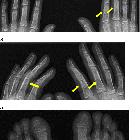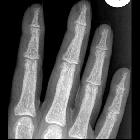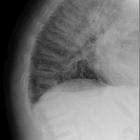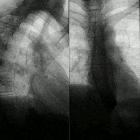acro-osteolysis

Lost bones:
differential diagnosis of acro-osteolysis seen by the pediatric rheumatologist. Frontal radiograph of the left hand in a 14 year old male patient with hyperparathyroidism demonstrates acro-osteolysis (arrowheads), subperiosteal resorption at the middle phalanges (small arrows), brown tumors (large arrows) and diffuse osteopenia

Hajdu-Cheney
Syndrome : acro-osteolysis of all distal phalanges, platybasia, thickened occipital bone, open sutures, and wormian bones. This picture was used in the following article: "Truncating mutations in the last exon of NOTCH2 cause a rare skeletal disorder with osteoporosis." Isidor B. & al. Nat Genet. 2011 Mar 6. https://www.ncbi.nlm.nih.gov/pubmed/21378989

Acro-osteolysis
• Acrosteolysis - Ganzer Fall bei Radiopaedia

Hyperparathyroidism
• Acro-osteolysis from end-stage renal failure - Ganzer Fall bei Radiopaedia

Erosive
Arthropathy in systemic sclerosis. X-ray of hands showing. - Erosion of the fourth and the fifth proximal inter phalangeal joint on the left hand. - Terminal phalangeal tuft resorption (arrow).

Lost bones:
differential diagnosis of acro-osteolysis seen by the pediatric rheumatologist. Frontal (a) and oblique (b) radiographs of the hands in a 14 year old male patient with primary hypertrophic osteoarthropathy demonstrate bilateral and symmetric tuft resorption and remodeling. Smooth periostitis involves the proximal phalangeal shafts (arrows). Frontal radiograph of the feet (c) shows smooth tapering of the distal tufts

Lost bones:
differential diagnosis of acro-osteolysis seen by the pediatric rheumatologist. Frontal radiograph of the toes in a 14 year old female patient with juvenile psoriatic arthritis demonstrates focal soft tissue swelling of the fourth digit, with tapering of the distal phalanx and resorption of the distal tuft cortex

Lost bones:
differential diagnosis of acro-osteolysis seen by the pediatric rheumatologist. Frontal radiographs of the hands in a 13 year old male patient with systemic sclerosis show tuft resorption consistent with acro-osteolysis. No soft tissue calcifications present

Hyperparathyroidism
• Hyperparathyroidism - musculoskeletal manifestations in the hands - Ganzer Fall bei Radiopaedia

Osteopetrosis.
Pycnodysostosis: Hand radiograph, age 3 years. Note acro-osteolysis in the distal phalanx of thumb and index fingers (arrows) and generalised increased bone density.

Scleroderma
(musculoskeletal manifestations) • Scleroderma - Ganzer Fall bei Radiopaedia

Psoriatic
arthritis • Psoriatic arthritis with acro-osteolysis - Ganzer Fall bei Radiopaedia

Acro-osteolysis
• Acro-osteolysis - Ganzer Fall bei Radiopaedia

Scleroderma
• Scleroderma - hand manifestations - Ganzer Fall bei Radiopaedia

Acro-osteolysis
• Scleroderma with acro-osteolysis - Ganzer Fall bei Radiopaedia

Acro-osteolysis
• Acro-osteolysis secondary to hyperparathyroidism - Ganzer Fall bei Radiopaedia

Sarcoidosis
• Skeletal sarcoidosis - Ganzer Fall bei Radiopaedia

Salt and
pepper sign (skull) • Hyperparathyroidism - Ganzer Fall bei Radiopaedia

Soft tissue
calcification • Hyperparathyroidism - Ganzer Fall bei Radiopaedia
Acro-osteolysis (plural: acro-osteolyses) refers to resorption of the distal phalanx. The terminal tuft is most commonly affected. It is associated with a heterogeneous group of pathological entities and, some of which can be remembered by using the mnemonic PINCH FO.
When there is linear bone resorption of the midshaft of the distal phalanx with a relatively spared terminal tuft, the condition is also referred to as band acro-osteolysis and carries a more limited differential diagnosis.
Pathology
Multiple digits
Terminal tuft resorption
- scleroderma
- Raynaud disease
- psoriatic arthritis
- thermal injury
- extreme cold: frostbite
- extreme heat: burns, electricity
- trauma
- hyperparathyroidism
- epidermolysis bullosa
- porphyria
- drugs
- phenytoin (occurs in infants of epileptic mothers treated with phenytoin)
- ergot poisoning/abuse
- insensitivity to pain, e.g. leprosy, congenital insensitivity to pain
- juvenile chronic arthritis
- dermatomyositis
- vascular occlusion
- reactive arthritis
- pityriasis rubra pilaris (very rare skin condition)
- pachydermoperiostosis
- sarcoidosis
Midshaft resorption (band acro-osteolysis)
- polyvinyl chloride (PVC) exposure
- primary acro-osteolysis: Hajdu-Cheney syndrome
- hyperparathyroidism (also causes terminal tuft resorption)
- scleroderma (also causes terminal tuft resorption)
- idiopathic non-familial acro-osteolysis
- pyknodysostosis (also causes terminal tuft hypoplasia)
- biomechanical in guitar players
Single digit
Siehe auch:
- Dermatomyositis
- primärer Hyperparathyreoidismus
- Systemische Sklerodermie
- epidermale Inklusionszyste
- Psoriasisarthritis
- CREST syndrome
- Lepra
- Glomustumor am Finger
- Hajdu-Cheney-Syndrom
- muskuloskelettale Manifestationen bei Sklerodermie
- PINCH FO
- Hereditäre idiopathische Osteolyse Typ IV Thieffry-Shurtleff
- Vinylchlorid-Krankheit
und weiter:

 Assoziationen und Differentialdiagnosen zu Akroosteolyse:
Assoziationen und Differentialdiagnosen zu Akroosteolyse:




